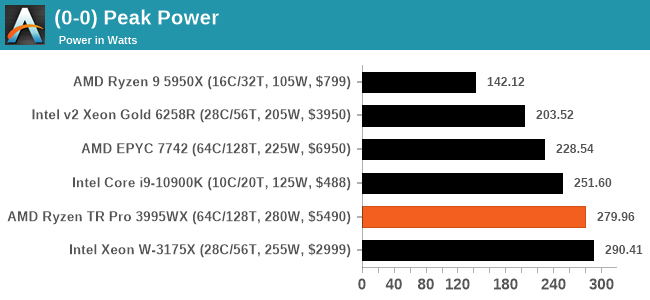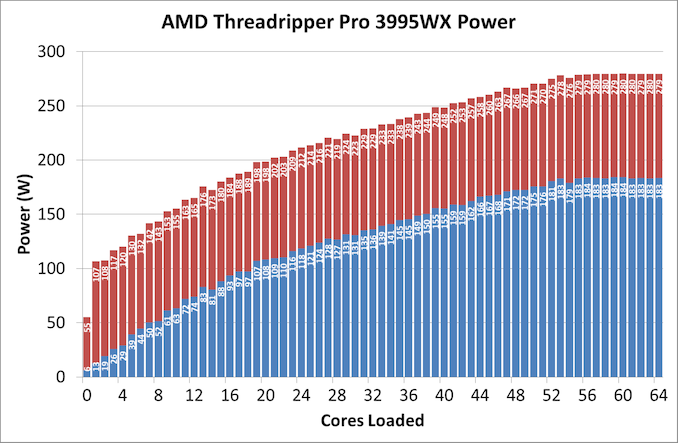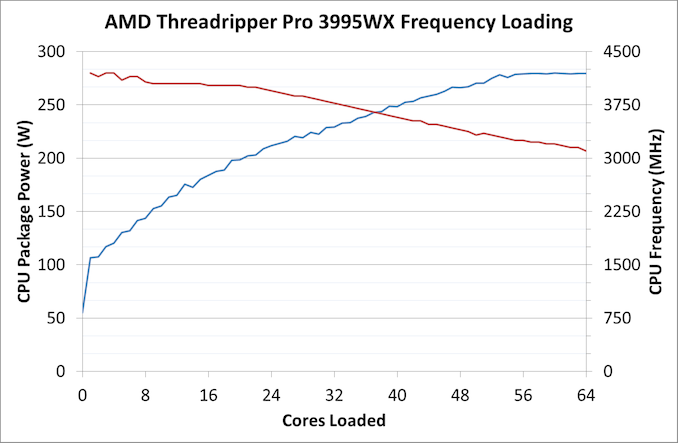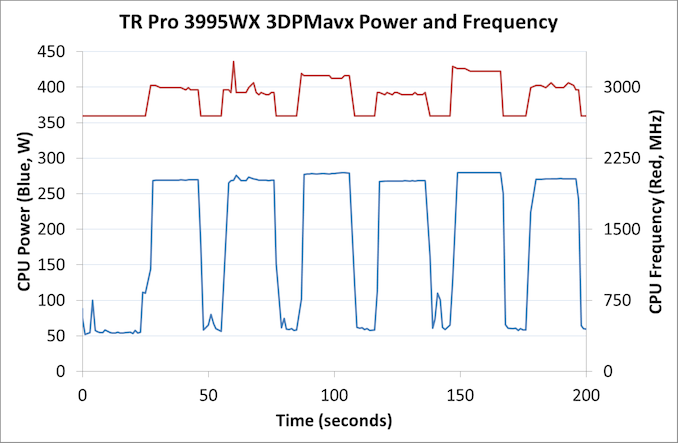64 Cores of Rendering Madness: The AMD Threadripper Pro 3995WX Review
by Dr. Ian Cutress on February 9, 2021 9:00 AM EST- Posted in
- CPUs
- AMD
- Lenovo
- ThinkStation
- Threadripper Pro
- WRX80
- 3995WX
Power Consumption
The nature of reporting processor power consumption has become, in part, a dystopian nightmare. Historically the peak power consumption of a processor, as purchased, is given by its Thermal Design Power (TDP, or PL1). For many markets, such as embedded processors, that value of TDP still signifies the peak power consumption. For the processors we test at AnandTech, either desktop, notebook, or enterprise, this is not always the case.
Modern high performance processors implement a feature called Turbo. This allows, usually for a limited time, a processor to go beyond its rated frequency. Exactly how far the processor goes depends on a few factors, such as the Turbo Power Limit (PL2), whether the peak frequency is hard coded, the thermals, and the power delivery. Turbo can sometimes be very aggressive, allowing power values 2.5x above the rated TDP.
AMD and Intel have different definitions for TDP, but are broadly speaking applied the same. The difference comes to turbo modes, turbo limits, turbo budgets, and how the processors manage that power balance. These topics are 10000-12000 word articles in their own right, and we’ve got a few articles worth reading on the topic.
- Why Intel Processors Draw More Power Than Expected: TDP and Turbo Explained
- Talking TDP, Turbo and Overclocking: An Interview with Intel Fellow Guy Therien
- Reaching for Turbo: Aligning Perception with AMD’s Frequency Metrics
- Intel’s TDP Shenanigans Hurts Everyone
In simple terms, processor manufacturers only ever guarantee two values which are tied together - when all cores are running at base frequency, the processor should be running at or below the TDP rating. All turbo modes and power modes above that are not covered by warranty. Intel kind of screwed this up with the Tiger Lake launch in September 2020, by refusing to define a TDP rating for its new processors, instead going for a range. Obfuscation like this is a frustrating endeavor for press and end-users alike.
However, for our tests in this review, we measure the power consumption of the processor in a variety of different scenarios. These include full AVX2/AVX512 (delete as applicable) workflows, real-world image-model construction, and others as appropriate. These tests are done as comparative models. We also note the peak power recorded in any of our tests.
AMD Ryzen Threadripper Pro 3995WX
The specifications for this processor list 64 cores running at a TDP of 280 W. In our testing, we never saw any power consumption over 280 W:

Going through our POV-Ray scaling power test for per-core consumption, we’re seeing a trend whereby 40% of the power goes to the non-core operation of the system, which is also likely to include the L3 cache.

Red = Full Package, Blue = CPU Core only (minus L3 we think)
We only hit the peak 280 W when we are at 56-core loading, otherwise it is a steady climb moving from 7 W/core in the early loading down to about 3 W/core when fully loaded. What this does for core frequencies is relatively interesting.
Our system starts around 4200 MHz, which is the rated turbo frequency, settling down to 4000-4050 MHz in that 8-core to 20-core loading. After 20 cores, it’s a slow decline at a rate of 25 MHz per extra core loaded, until at full CPU load we observe 3100 MHz on all cores. This is above the 2700 MHz base frequency, but also comes out to 2.86 W per core in CPU-only power, or 4.37 W per core if we also include non-CPU power. Note that non-CPU power in this case might also include the L3.
For an actual workload, our 3DPMavx test is a bit more aggressive than POV-Ray, cycling to full load for ten seconds for each of its six algorithms then idling for a short time. In this test we saw idle frequencies of 2700 MHz, but all-core loading was at least 2900 MHz up to 3200 MHz. Power again was very much limited to 280 W.












118 Comments
View All Comments
kwinz - Wednesday, February 10, 2021 - link
Really? CPUs are in high demand because GPU programming is hard? That's what you're going with?Gomez Addams - Wednesday, February 10, 2021 - link
Good heavens that was painful to read. Some of the worst writing have had to suffer through in a while. One tip : compute is a verb and not a noun, just as simulation is a noun and simulate is a verb. Just because marketing droids use a term does not mean it is correct.Spunjji - Thursday, February 11, 2021 - link
Sorry pal, language doesn't work that way. You may not *like* it, but that's the way it is!croc - Wednesday, February 10, 2021 - link
Are we now ignoring the elephant? EPYC was to launch in 2020. Actually, AMD said that Zen 3 would launch in 2020, but there's a weasel in them words... SOME of the Zen 3 cpu's DID launch, mostly looking like paper though. EPYC is sort-of launching as we speak, and Zen 3 Threadripper is a no-show.I have said this elsewhere, and I will say it here. It would appear that AMD's lack of fab experience is showing, as they seem to be having issues getting their designs to fab properly at 7nm. Low to no yields? And TSMC is having issues of their own with China buying up as much talent as it can, while threatening to just grab it all in a military takeover. TSMC should have already built an advanced fab somewhere in the west, out of China's reach. Europe? Canada? After Trump, I would say to avoid the US as much as it needs to avoid China.
Spunjji - Thursday, February 11, 2021 - link
AMD were hoping to get Milan into production in Q3 2020 and have it shipping to some customers by Q4, which they did. It's not available to OEMs yet, so hardly a fanfare moment, but not the "elephant" you're trying to paint it as either.Same goes for Zen 3, too - it absolutely wasn't a "paper launch" - but I see you're just here to push FUD rather than discuss *the article*.
Like, what's this "they seem to be having issues getting their designs to fab properly at 7nm" crap? Whose backside are you pulling that out of?
Amazing how many people seem to think these comment sections are the ideal place to grind their own personal political axes.
Oxford Guy - Thursday, February 11, 2021 - link
‘Amazing how many people seem to think these comment sections are the ideal place to grind their own personal political axes’You seem to think this is your personal website.
Qasar - Thursday, February 11, 2021 - link
as do you, point is ?Oxford Guy - Wednesday, March 10, 2021 - link
It’s not the tu quoque fallacy.tygrus - Thursday, February 11, 2021 - link
If total desktop sales were 20Million in 2020Q4 and if AMD sold 5M with about 0.95M being Zen3 so AMD could have been 19% of desktop CPU sales being Zen3. That's a good start and a lot better than <5% you may think happens for a paper launch. Notebook market adds another 50M/qtr (20% AMD?) and tablets (probably not AMD) on top of that so Zen3 sales would look like ~7% of AMD consumer CPU's sold that qtr.Not all sales & deliveries are publicised so server sales may have happened already for Zen3. The FAB capacity & yield were more than enough because it was the substrate & final assembly which limited supply.
ipkh - Sunday, February 28, 2021 - link
Really, they have Global Foundries to thank for this. Global Foundries miseead the market and decided to drop highend node production. This left TSMC as the only highend node company left standing (that does 3rd party fab). Global Foundries and Samsung could have had a much better roadmap working together with IBMs researchers. But they didn't and now we see how much it is costing the entire industry. AMD may be forced to use Samsung Foundries if TSMC production gets tied up.